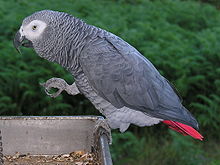
Back ببغاوات وجواثم Arabic Psittacopasserae Czech Psittacopasserae Spanish طوطیگنجشکمانان Persian Mosk- en pappegaai-eftigen Frisian Psittacopasserae Italian Dirûvdanê çivîkan Kurdish Papagaiļu un zvirbuļu virskārta Latvian/Lettish Попугай дон оравивлӓ MRJ Psittacopasserae Malay
| Psittacopasseres | |
|---|---|

| |
| House sparrow, Passer domesticus | |

| |
| Grey parrot, Psittacus erithacus | |
| Scientific classification | |
| Domain: | Eukaryota |
| Kingdom: | Animalia |
| Phylum: | Chordata |
| Class: | Aves |
| Clade: | Eufalconimorphae |
| Clade: | Psittacopasseres Suh et al., 2011 |
| Subtaxa | |
| |
| Synonyms | |
|
Psittacopasserae Suh et al., 2011 | |
Psittacopasseres is a taxon of birds consisting of the Passeriformes (passerines, a large group of perching birds) and Psittaciformes (parrots).[3] Per Ericson and colleagues, in analysing genomic DNA, revealed a lineage comprising passerines, psittacines and Falconiformes.[4] The group was proposed following an alignment of nuclear intron sequences by Shannon Hackett et al. in 2008.[5] It was formally named as Psittacopasserae in a 2011 Nature Communications article by Alexander Suh and other authors working with Jürgen Schmitz's group,[6] based on genetic analysis of the insertion of retroposons into the genomes of key avian lineages over the course of evolution during the Mesozoic Era. This clade was defined in the PhyloCode by George Sangster and colleagues in 2022 as the least inclusive crown clade containing Psittacus erithacus and Passer domesticus.[3] [clarification needed]
- ^ Boles, Walter E. (1997). "Fossil songbirds (Passeriformes) from the Early Eocene of Australia". Emu. 97 (1): 43–50. Bibcode:1997EmuAO..97...43B. doi:10.1071/MU97004.
- ^ Kuhl., H.; Frankl-Vilches, C.; Bakker, A.; Mayr, G.; Nikolaus, G.; Boerno, S. T.; Klages, S.; Timmermann, B.; Gahr, M. (2020). "An unbiased molecular approach using 3'UTRs resolves the avian family-level tree of life". Molecular Biology and Evolution. 38: 108–127. doi:10.1093/molbev/msaa191. PMC 7783168. PMID 32781465.
- ^ a b Sangster, George; Braun, Edward L.; Johansson, Ulf S.; Kimball, Rebecca T.; Mayr, Gerald; Suh, Alexander (2022-01-01). "Phylogenetic definitions for 25 higher-level clade names of birds" (PDF). Avian Research. 13: 100027. Bibcode:2022AvRes..1300027S. doi:10.1016/j.avrs.2022.100027. ISSN 2053-7166.
- ^ Ericson, P. G. P.; Anderson, C. L.; Britton, T.; Elzanowski, A.; Johansson, U. S.; Källersjö, M.; Ohlson, J. I.; Parsons, T. J.; Zuccon, D.; Mayr, G. (2006). "Diversification of Neoaves: integration of molecular sequence data and fossils". Biology Letters. 2 (4): 543–547. doi:10.1098/rsbl.2006.0523. PMC 1834003. PMID 17148284.
- ^ Shannon J. Hackett; et al. (2008-06-07). "A Phylogenomic Study of Birds Reveals Their Evolutionary History". Science. 320 (5884): 1763–1768. Bibcode:2008Sci...320.1763H. doi:10.1126/science.1157704. PMID 18583609. S2CID 6472805.
- ^ Alexander Suh; et al. (2011-08-23). "Mesozoic retroposons reveal parrots as the closest living relatives of passerine birds". Nature Communications. 2 (8): 443. Bibcode:2011NatCo...2..443S. doi:10.1038/ncomms1448. PMC 3265382. PMID 21863010.